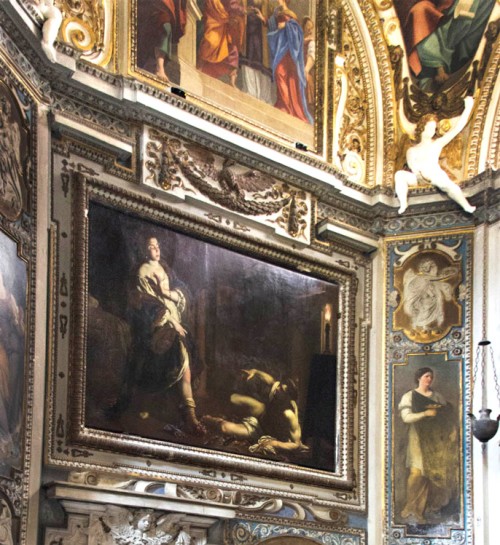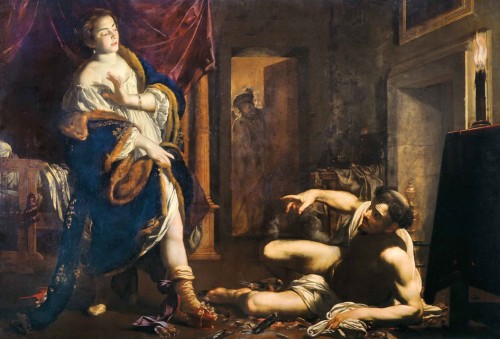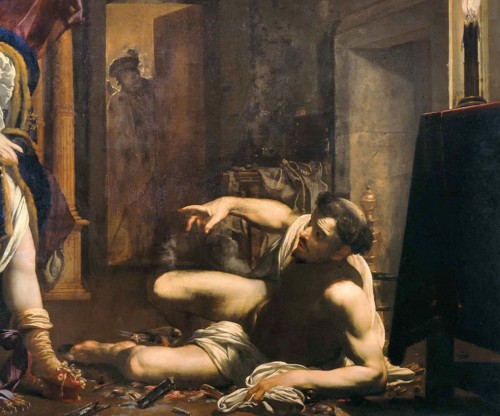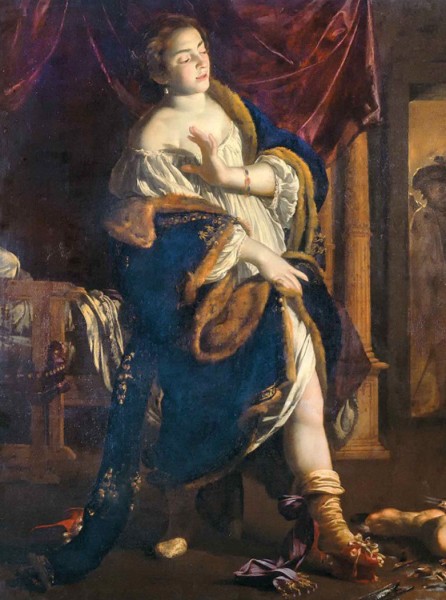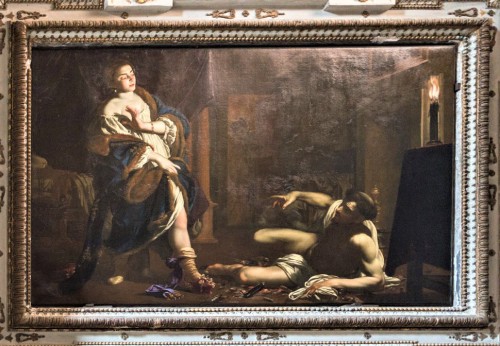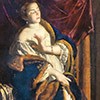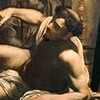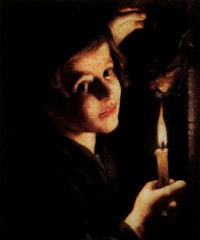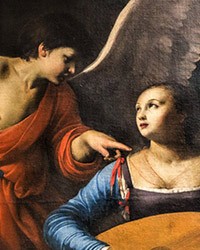The Temptation of St. Francis – a lesson in the taming of the senses
However, let us start at the beginning, meaning with a small booklet entitled The Little Flowers of Saint Francis, written between the XII and XIV centuries and later edited numerous times. In the twenty-fourth chapter of this short story about the life of the saint, written after his death, we find out about Francis’s journey to Babylon to the court of the sultan where “pushed by the zeal of faith and the desire for martyrdom, he sailed across the sea with twelve of the holiest companions”. The sultan allowed the newcomer to spread the word of God in his land without any obstacles, however, the Poor Man of Assisi had quite an adventure during this pilgrimage. As the story would have it he was lured to the house of a certain beautiful woman with an "impure soul”. She invited him to her bed and he conceded saying “I agree, let us go". Then he took off his clothes and threw himself into the fireplace, at the same time calling the terrified woman to him and saying: “Take off your garments and come enjoy this sparkling, blooming, and wonderful bed; for it is here you must come if you would like to be with me". In disbelief, the woman looked upon the smiling Francis, who despite being surrounded by flames, did not burn. This is the very moment we will see in the painting of the French painter Simon Vouet in the Chapel of St. Hyacintha Marescotti (Alaleone) in the Church of San Lorenzo in Lucina. The gesture of the woman's hand seems to express disdain at sharing a bed on the burning embers but at the same time interest and curiosity. Dressed in a nightgown, her shoulders are covered by a fur-lined coat, which she holds with her left hand. The nightgown falls off her shoulder showing the pure alabaster of her firm body. One foot with a gold slipper is barely visible, and the other – half-nude – protrudes forward. The stocking with satin garter has already fallen to her calf, but the foot is still leaning on a platform shoe – footwear typical for women of questionable reputation. Her hands, ears, and wrist are adorned with jewelry. Behind the woman, we can see a bed with linen lying about in disarray. We do not see the fireplace itself, while the nude Francis is lying on the embers on the floor. His genitals are covered with a white bedsheet, perhaps taken off the bed of the harlot, while the robes of the monk can be seen discarded in the background. He is raising his hand as if in a gesture of invitation, and is looking closely upon the face of the woman, while his lips seem to be speaking – a that moment he is most likely inviting her to share his bed. We find ourselves in a richly decorated interior almost luxurious, most likely in the room of an elegant courtesan. There are tapestries and paintings on the wall, however, the element that attracts our attention is the burning candle placed on the window. It had special significance. In houses of ill repute, it was a sign for the clients that the room was occupied. This was the source of the popular term ragazza della candela, meaning a woman who provided sexual services, where the duration was measured by the burning candle. However, it is not the candle, that is the source of such an intense light, which illuminated both the protagonists. The candle is but a third element of the composition built on a triangle. The source of the light, but also the alleged fire is located in the lower right-hand corner – the unseen fireplace hidden from view by a dresser covered with cloth and it is this fire which illuminates the woman. Francis on the other hand is brightened by a glow, whose source is found outside the painting.

What is ultimately the conclusion of the story of the harlot and the humble monk found on the pages of The Little Flowers of St. Francis? As we can imagine, Francis was able to calm his senses, while the terrified woman in the face of the miracle, became aware of the sinfulness of her life, left her profession, and believed in Christ. Shortly after Francis left Babylon deeming his mission a failure since the harlot was the only convert, besides the sultan who had been baptized upon his deathbed, but only by Franciscans sent later by Francis himself.
When we look closely at this scene, we will find a barely visible figure in the slightly ajar door of the room – who is it? Many art historians have tried to solve this mystery. Some saw in it the devil looking into the room to test his power and the power of Francis’s will. However, it seems that the answer is provided by yet another literary work created at the end of the XIV century –a sort of a guidebook for the members of the Franciscan Order – Liber Conformitate vitae St. Francisci ad vitam Domini Iesu (known as De Conformitate) written by Bartholomew of Pisa. In this work, officially published only at the beginning of the XVI century, the life of Francis is compared to the life of Jesus, while the story discussed here does not take place in the land of the sultan, but in the Italian town of Bari. The man who plays the host to the monk is the hated by the Church, and excommunicated Emperor Frederick II. Although both men lived during the same period, it is difficult to imagine two figures more distant from each other. One symbolized unwavering faith, humility, and virtue of restraint, the other – referred to as Antichrist by the pope – personified a pagan way of life, freemasonry, and a love for Arabian dresses and Arabian dancers. Most likely they never met, however, upon the pages of De Conformitate, the emperor invited Francis to his court and wanted the saint to undergo a test being shut in a room with a sensual woman. And so it was the emperor along with his entourage who was opening the door to check Francis’s virtue.
The painting The Temptation of St. Francis, similar to another canvas painted by Vouet found on the other side of the chapel (St. Francis Renouncing his Goods) was commissioned by its founder Paolo Alaleone – the master of ceremonies at the court of subsequent popes. And it was probably he, who chose Francis as the patron of his place of burial. What was it, that drew him to the saint – the renouncement of bodily pleasures or perhaps the courage and uncompromising attitude of Francis, or maybe the disdain for the earthly word and its shining trinkets – that is difficult to say. Perhaps, the direct inspiration was the fate of another Francis connected with the Church of San Lorenzo in Lucina. This was Ascanio Caracciolo – the co-founder of Order of the Clerics Regular Minor, established in 1588, which was assigned to this very church by Pope Paul V. The task of the order was to care for the poor, the sick, and prisoners. Caracciolo was a great enthusiast of St. Francis and even changed his name in his honor. The pious life which he led, gained him universal renown among the faithful, and ultimately (at the beginning of the XIX century) brought him sainthood. And although he died fifteen years prior to the creation of the painting (1608), the stories surrounding him were still alive in the parish, to which the founder of the chapel belonged. The heroine of one of these stories, written in the chronicles of the order was a prostitute who lived near the church and once visited Caracciolo’s chamber. In the presence of a man who was so holy and so pure the woman felt great remorse and left, and the next day she came to confession. As a consequence she joined one of the houses for converted prostitutes (Casa di Convertire) that was located by the convent, to spend the rest of her life there. Therefore, the figure of Francis selected by the client as a topic for the paintings could have referred to two significant people. Both led not only an exemplary and virtuous life but both were also able to convert sinful women, which at the time of the Counterreformation was particularly valued and accentuated. It must be assumed that the work of Vouet targeted a broad audience but especially monks who were active at San Lorenzo in Lucina. It was to remind them of the great significance of the mission of converting prostitutes onto the virtuous path of life and of admonishing their clients. It also concerned the restraint of the monks themselves. This was not an easy task, since the church was located near the so-called Ortaccio di Campo Marzio, meaning a red-light district where Roman prostitutes resided. At that time, this place was a sort of ghetto, with gates closed for the night, that stretched between the Tiber and the Piazza Monte d'Oro.

The iconographic scheme of the paintings completed by Vouet was probably discussed and agreed upon not only with the client but also with the clergymen from the Church of San Lorenzo in Lucina. When we take a look at the contrast between the dark-filled room and the sharp light coming from Francis lying on the floor, we can be under the impression that we are looking at the illustration of the words of St. Paul calling upon monks to avoid the deeds of darkness by donning “an armor of light”, that will protect them against all weakness (Rom 13.12-14). They were expected to emulate the attitude of St. Francis meaning avoiding all temptations of the flesh. This pretty much became a regulation after the Council of Trent, when once again the significance of celibacy was emphasized. If until then it was treated rather lightly, from then on virginity and a pious life, also expected of the clergy, were glorified above all. It was repeated with emphasis that heavenly love satisfies not only the flesh but also the soul, while the love of God should be enough to quench the flames of desire and all other temptations. Vouet's painting therefore sheds light onto the problems with which the clergy struggled when celibacy was introduced in the Church. This also meant no more tolerance for Roman prostitutes and a conviction that for a city (dominated by the male population), they were a lesser evil. Now came the times of repression. The monks from the Church of San Lorenzo were tasked with converting, punishing, and disciplining fallen women, fighting against cohabitation, supporting single mothers and wives living in separation from their husbands, and the care for girls born and often left by prostitutes, who then landed on the streets. The problem was immense, similar to the responsibilities of the monks, and the stories about converted prostitutes were to bolster their spirit and give them the strength to continue their hard work.

Vouet, as an imitator of Caravaggio took from him the strong lighting contrasts, but he took just as much from his other fellow painters such as Gerrit van Honthorst and Trophime Bigot – to name only those who with great expertise introduced artificial light into their painting compositions (candles, torches, lamps), creating atmospheric nocturnes. From van Honthorst (or more appropriately from his painting The Beheading of St. John the Baptist) Vouet probably took the gesture of the left hand of Francis's temptress, but also the rich chromatic scheme. A significant color element of both paintings is the valued at that time ultramarine, with which the coat of the woman was painted, while the rest is nearly monochromatic.
Vouet in a very skillful way showed us a kingdom of luxury, shining baubles, and gleaming materials and confronted this wealth with the flame of lust and desire which is put out by the unwavering faith of the saint ascetic. Francis emerged victorious from his struggle, sin was conquered, the fallen woman was saved, while the Church and virtue once again triumphed which is the moral of this extremely beautiful painting scene.
The Temptation of St. Francis, Simone Vouet, 1624, oil on canvas, 185 cm x 252 cm, Chapel of Hyacintha Marescotti, Church of San Lorenzo in Lucina
If you liked this article, you can help us continue to work by supporting the roma-nonpertutti portal concrete — by sharing newsletters and donating even small amounts. They will help us in our further work.
You can make one-time deposits to your account:
Barbara Kokoska
BIGBPLPW 62 1160 2202 0000 0002 3744 2108 or support on a regular basis with Patonite.pl (lower left corner)
Know that we appreciate it very much and thank You !


